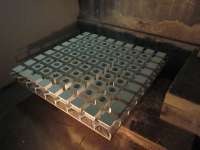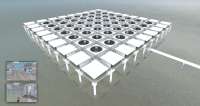A call for unrealized projects
Msquare4 You walk on an apparently miles long quay and all of a sudden a museum building arises. This time on poles over the water, but Msquare4 can be placed in every desired environment. Msquare4’s floor-plan is a grid, made up of a varying number of identical rooms: a structured pattern, but treacherous like a labyrinth. Via sliding doors four adjacent rooms are continually accessible: the origin of the title Msquare4. This virtual museum model represents unprecedented freedom, because the routing is left to the visitor. The guided route through a museum is only successful when not noticed. Routing determines the order of an exhibition, but at the same time also influences the way the art is experienced. Artificial relations and associations, given in displayed texts and in the order of the artworks, blur the personal experience of the visitor. The paved track, the curator’s message, is almost inescapable. However, when art is placed in an independent space - that is a space connected to neither the preceding room nor the next - it can be judged by its specific qualities and so be truly autonomous. With Msquare4 Dutch artist André Kodde concedes to the autonomy of art.
Developed over the past three years, first in dreams of a physical building, thereafter as a virtual project, Msquare4 is not nearly completed. Either virtual or physical, the building turned out to be too expensive to realize. The case is closed as far as the physical building goes and the website is still under construction: Msquare4 is leading a slumbering existence. Msquare4 is not just an utopian building, it is an artwork. It is a stage for new art that is especially suitable and/or made for this virtual formula. This includes interactive sound art, digital prints or video art: art that only exists because of the virtual world. The museum model itself makes the presentation of these artworks or exhibitions possible, but is at the same time inextricably part of the artistic whole. Msquare4 unites a totality in itself: artworks and platform become one.
The financial issue is not the only problem. Unfortunately, there is still not enough truly virtual art to continuingly fill Msquare4’s rooms. However, that doesn’t mean the concept is useless. The mere existence of the idea and the display of its evidence – a scale model, the website and concepts for future exhibitions – can still inspire people to think about museums differently.
Even though there is a lot of institutional critique coming from artists, there are enough reasons left to honour old institutions such as museums. In today’s rapidly digitalizing world the museum still serves a purpose. It gathers together people with a shared interest, be it physically or virtually, but in order to adapt to nowadays needs and standards it should remain flexible. When flexible, an institutional can be revolutionary. New art for a new kind of institution, even if only in our dreams, is something worth visualizing.
A call for unrealized projects
Msquare4 You walk on an apparently miles long quay and all of a sudden a museum building arises. This time on poles over the water, but Msquare4 can be placed in every desired environment. Msquare4’s floor-plan is a grid, made up of a varying number of identical rooms: a structured pattern, but treacherous like a labyrinth. Via sliding doors four adjacent rooms are continually accessible: the origin of the title Msquare4. This virtual museum model represents unprecedented freedom, because the routing is left to the visitor. The guided route through a museum is only successful when not noticed. Routing determines the order of an exhibition, but at the same time also influences the way the art is experienced. Artificial relations and associations, given in displayed texts and in the order of the artworks, blur the personal experience of the visitor. The paved track, the curator’s message, is almost inescapable. However, when art is placed in an independent space - that is a space connected to neither the preceding room nor the next - it can be judged by its specific qualities and so be truly autonomous. With Msquare4 Dutch artist André Kodde concedes to the autonomy of art.
Developed over the past three years, first in dreams of a physical building, thereafter as a virtual project, Msquare4 is not nearly completed. Either virtual or physical, the building turned out to be too expensive to realize. The case is closed as far as the physical building goes and the website is still under construction: Msquare4 is leading a slumbering existence. Msquare4 is not just an utopian building, it is an artwork. It is a stage for new art that is especially suitable and/or made for this virtual formula. This includes interactive sound art, digital prints or video art: art that only exists because of the virtual world. The museum model itself makes the presentation of these artworks or exhibitions possible, but is at the same time inextricably part of the artistic whole. Msquare4 unites a totality in itself: artworks and platform become one.
The financial issue is not the only problem. Unfortunately, there is still not enough truly virtual art to continuingly fill Msquare4’s rooms. However, that doesn’t mean the concept is useless. The mere existence of the idea and the display of its evidence – a scale model, the website and concepts for future exhibitions – can still inspire people to think about museums differently.
Even though there is a lot of institutional critique coming from artists, there are enough reasons left to honour old institutions such as museums. In today’s rapidly digitalizing world the museum still serves a purpose. It gathers together people with a shared interest, be it physically or virtually, but in order to adapt to nowadays needs and standards it should remain flexible. When flexible, an institutional can be revolutionary. New art for a new kind of institution, even if only in our dreams, is something worth visualizing.

